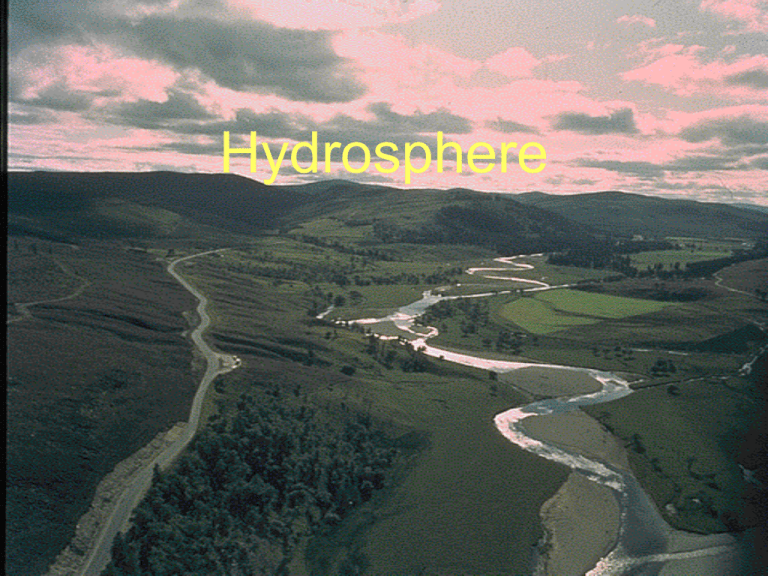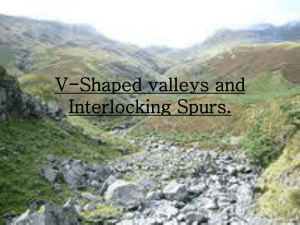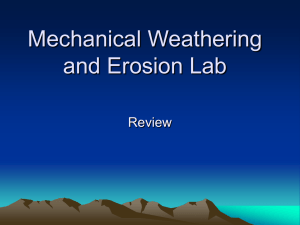Hydro 1 - Clydebank High School
advertisement

Hydrosphere Atmospheric Water 0.001% Ice 2.15% Soil water 0.005% 97.2% Ground Water 0.62% Ice storage condensation Precipitation Evapotranspiration Evaporation Infiltration Water Table Percolation Hydrological Cycle • Evaporation: The transfer of water from the sea to the air as water vapour. •Condensation: Water vapour (gas) changes back into water (liquid). It forms small droplets which are visible as clouds. •Precipitation: Water falls to earth as either liquid (rain) or in a frozen state (snow, hail). •Stream / Surface Run Off: Most water returns to the sea in the form of rivers. •Evapotranspiration: •Transpiration: The transfer of water from plants to the air as water vapour. •Ground water Flow: Some water returns to the sea as groundwater through soil and rocks. •Infiltration: The point at which rainfall seeps into soil. •Percolation: The seepage of water downwards through rocks. •Throughflow: The movement of water downwards through soil back to the sea. •Groundwater Zone: Storage area for water which is slowly released back to the sea via springs and rivers. River Basins • Aims Describe and explain the formation of key features of a rivers course with reference to specific erosional processes. The Drainage Basin The basic system of surface drainage is known as a river basin. This consists of a complex interaction of components which include rainfall, channel run – off , surface streams, soils, slope, solar energy, groundwater storage, evaporation from surface and evapotranspiration from vegetation. The system returns water to the oceans and seas as part of the hydrological cycle. River Basin Source of River Clyde Watershed of River Clyde (boundary between basins) Tributary of River Clyde Confluence of River Clyde and tributary Estuary of River Clyde Flood plain Mouth of River Clyde Sea Source of river Aims Upper Course Describe the physical characteristics of a river and its valley Explain the formation of waterfalls, Vshaped valleys, meanders and oxbow lakes. Middle Course Lower Course How rivers erode HYDRAULIC ACTION / Water and air are forced into cracks on the river bank, exerting a pressure. When this process is repeated many times it causes erosion. ABRASION The material carried in the river wears away the river bed ATTRITION As the pebbles carried by the river crash into each other,they become smaller and rounder SOLUTION The water in the river dissolves the minerals in the rocks Leave a space between each to draw a picture of the types of erosion. How rivers transport Traction Suspension Rolling stones along the river bed.( needs lots of energy) Clay sized particles are carried along by the river flow river flow Saltation Sand sized particles bounce along the riverbed Solution Some minerals are dissolved by the riverwater Upper Course Middle Course Lower Course Characteristics Slope Upper Course usually steep Middle Course Lower Course quite steep gentle Width narrow quite wide wide Depth shallow quite deep deep Straightness winding meandering Type of load Main work Valley width large/small angular medium/small rounded big meanders small+ rounded erosion Transportation transportation transportation deposition narrow quite wide wide FEATURES OF THE UPPER COURSE V-SHAPED VALLEYS WITH INTERLOCKING SPURS POT HOLES ON RIVER BED WATERFALLS AND RAPIDS Upper Course In the upper course of the river the gradient is very steep and the river when flooded is fast flowing causing hydraulic action. The sides of the valley are steep and the main work is erosion. The erosion process is greatest during periods of heavy rainfall as the river has more energy to affect the bedload as material is transported either by being rolled (traction) and bounced (saltation). Upper course is also affected by climate (freeze – thaw), rock types (soft & hard), local vegetation and slightly acidic rain (corrosion) causing a chemical reaction which erodes away rock. Interlocking spurs are fingers of hard rock that the river cannot erode, so it flows around them. Potholes are holes eroded in the river bed by stones being spun in the water (abrasion) So how does a v-shaped valley form? 1. Vertical erosion (in the form of abrasion, hydraulic action and solution) in the river channel results in the formation of a steep sided valley 2. Over time the sides of this valley are weakened by freeze thaw weathering processes and continued vertical erosion at the base of the valley 3. Gradually mass movement of materials occurs down the valley sides, gradually creating the distinctive v-shape. 4. This material is then gradually transported away by the river when there is enough energy to do so. As the river flows through the valley it is forced to swing from side to side around more resistant rock outcrops (spurs). As there is little energy for lateral erosion, the river continues to cut down vertically flowing between spurs of higher land creating interlocking spurs So how does a v-shaped valley form? 1. V________ erosion (in the form of a________, h____________ action and solution) in the river channel results in the formation of a steep sided valley 2. Over time the sides of this valley are w____________ by f________ t_________ w_____________ processes and continued vertical erosion at the base of the valley 3. Gradually m_______m____________ of materials occurs down the valley sides, gradually creating the distinctive v-shape. 4. This material is then gradually transported away by the river when there is enough energy to do so. As the river flows through the valley it is forced to swing from side to side around more resistant rock outcrops (spurs). As there is little energy for lateral erosion, the river continues to cut down vertically flowing between spurs of higher land creating interlocking spurs Key Term Check V-shaped Valley - a valley which resembles a 'v' in cross section. These valleys have steep sloping sides and narrow bottoms. Interlocking Spur - spurs are ridges of more resistant rock around which a river is forced to wind as it passes downstream in the upper course. Interlocking spurs form where the river is forced to swing from side to side around these http://www.cleo.net.uk/resources/displayframe.php?src=308/consultants_resources%2F_files%2Fintespur2.swf Waterfall formation http://www.school-portal.co.uk/GroupDownloadFile.asp?file=21604 WATERFALL RETREATS . UPSTREAM . . . OVERHANG UNDERCUTTING OF SOFT ROCK PLUNGE POOL Picture Paragraph • The river will slowly undercut the hard rock by eroding the soft rock underneath it. • This is enhanced by the swirling of broken rock in the plunge pool underneath the over hang. • The combined effect of falling water and the swirling rock erodes downwards – abrasion – and backwards Hydraulic action. • As the overhang gets larger and protrudes further it will collapse under is own weight. • The rock from the overhang will further erode the plunge pool. • Repeated overhangs and collapses over time will result in a narrow, steep sided gorge. 1.Continuous erosion by the river will see the gradual undercutting of the slower eroding hard rock by the quickly eroding soft rock. 2.This is enhanced by the swirling of broken rock (eroded rock) in a plunge pool underneath an overhang. 3. The combined effect of the falling water and swirling rocks is to erode downwards – abrasion – and backwards- Hydraulic Action. 4. As the overhang gets larger and protrudes further it will eventually collapse under its own weight to form a new cliff. 5. The rock from the collapse will then be used to erode the resulting cliff and enlarge the plunge pool. 6. Repeated over time a series of overhangs and collapses occur, resulting in a steep sided & narrow gorge being formed. FORMATION OF A WATERFALL 1.Continuous erosion by the river will see the gradual u_______________ of the slower eroding hard rock by the quickly eroding soft rock. 2.This is enhanced by the s_____________ of broken rock (eroded rock) in a p_________ p__________ underneath an o_______________. 3. The combined effect of the falling water and swirling rocks is to erode downwards – a_________________ – and backwards- H_____________ A_____________. 4. As the overhang gets larger and protrudes further it will eventually c____________ under its own w___________ to form a new cliff. 5. The rock from the collapse will then be used to erode the resulting cliff and enlarge the p__________ ___________. 6. Repeated over time a series of overhangs and collapses occur, resulting in a steep sided & narrow g________ being formed. MEANDERS Meanders Flood plain © Used with the permission of the Geological Survey of Canada Available at http://sts.gsc.nrcan.gc.ca/clf/landscapes.asp NARROW MEANDER NECK FUTURE OX-BOW LAKE tributaries V shaped valley Steep Valley sides meander ox-bow lake Flood plain Reproduced with the permission of the Controller of HMSO © Crown Copyright NC/02/15232









